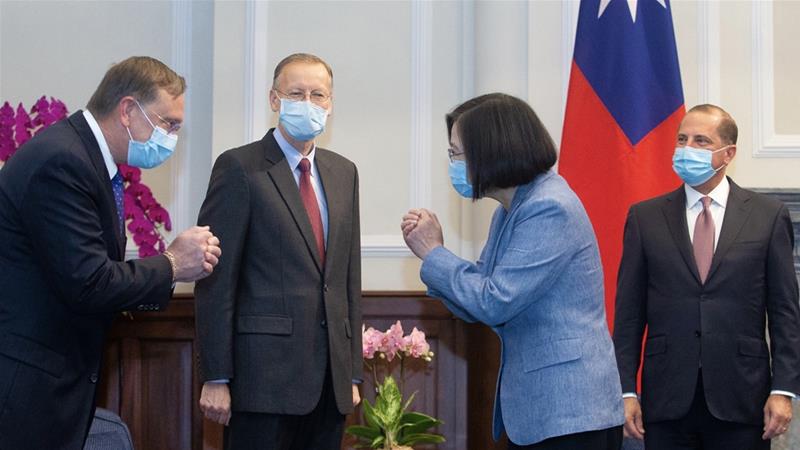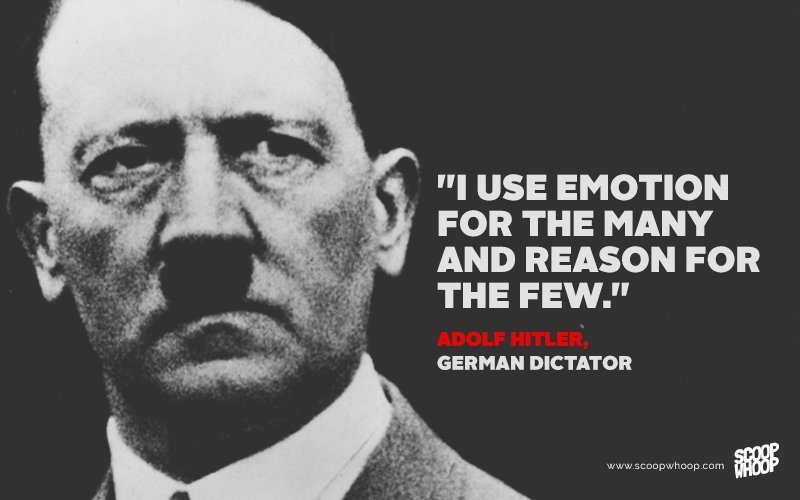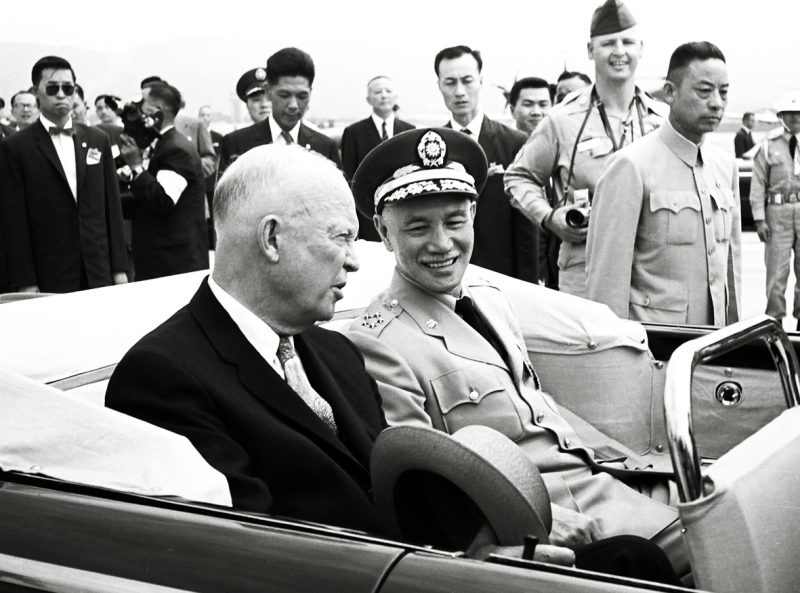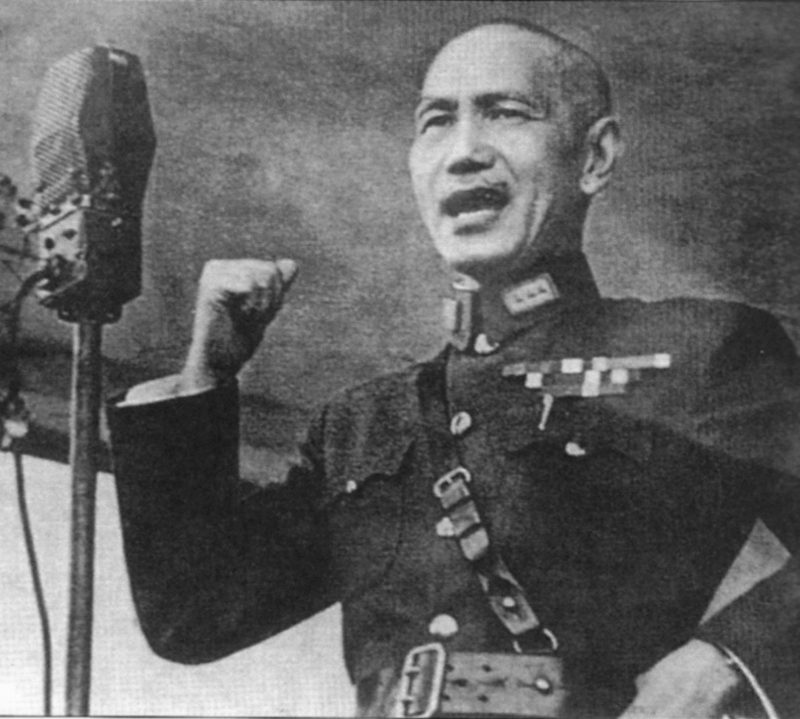It has never been more necessary than now that the EU should finally break away from the highly dangerous policy of the “only world power”, which feels threatened and which is contrary to human rights and international law.

Under U.S. guidance, the regime of Generalissimo Chiang Kai-Shek was installed in Taiwan beginning in 1945: He had already been supported by the USA in the 1920s, then also by Hitler’s Germany.
Taiwan is being instrumentalized against the People’s Republic of China, again intensified since U.S. Presidents Obama and Trump.
The current U.S. President Biden is even toying with a possible war with the help of Taiwan.
At the end of the 19th century, China was simultaneously subjugated and exploited by all colonial powers of the time — especially by Great Britain with the help of the annexed territory of Hong Kong (crown colony since 1843), but also by Russia, France, Italy, the Netherlands, Belgium, Portugal, and finally also by the colonial newcomers USA, Japan and Germany.
In a joint war campaign, they bombed the capital Beijing, then set up embassies there and took command of the formally continuing Chinese government.
The colonial powers raided enormous wealth with their trading companies, banks, mines and corporations, crushed uprisings (most famously the “Boxer Rebellion”), destroyed the rule of law, civil society, order, government and the environment.
Partial modernization and industrialization along Western lines simultaneously benefited a tiny Chinese elite.
The country was plunged into deep poverty, disorganization and depression (mass sale of opium by British companies from Hong Kong).
Local warlords, collaborating with the colonialists, exploited the ungovernability. Millions of people starved, vegetated, were killed for resisting and rebelling.
Bourgeois Revolution: Sun Yatsen 1912
The bourgeois-radical revolutionaries under Sun Yat-sen and his Kuomintang Party ousted the Chinese collaborationist government in 1912 and declared the Republic of China.
Sun Yat-sen was supported also by the Soviet Union, the Comintern, and the Chinese Communist Party, which was founded in 1921.
In contrast, the colonialist victorious powers of World War 1 in the Treaty of Versailles under the leadership of U.S. President Woodrow Wilson (1919) allowed Japan’s rule over the Chinese island of Taiwan, annexed in 1895, to continue and even transferred rule over the previous German colony of Quingdao to the further rising imperial power of Japan.
England’s annexation of Hong Kong remained in place, as did Portugal’s annexation of Macao.
The United States, in particular, continued to treat China as one of its spheres of influence: Standard Oil took over the oil and gasoline business, the Rockefeller Foundation financed the medical department of Peking University, and the lavishly funded missionary organizations Young Men’s Christian Association (YMCA) and Young Women’s Christian Association (YWCA) established schools and boarding schools in many cities. Sun Yatsen’s government could not withstand these influences.

USA and Hitler support dictator Chiang Kai-Shek
After SunYat-sen’s death in 1925, the old feudal and U.S.-British oriented elites prevailed in China.
They relied on General Chiang Kai-shek as the new dictatorial leader of the Republic of China.
He was simultaneously head of the military and the government.
He was supported by the United States with a lot of money for his army, also for his personal lifestyle, which included an extensive court.
Nazi Germany also recognized a kindred spirit in Chiang: Hitler Youth organized tent camps in China.
Hitler sent Wehrmacht generals Hans von Seeckt and Alexander von Falkenhausen as military and industrial advisors.
The German corporations IG Farben, Junkers, Heinkel, Rheinmetall, Messerschmitt, Krupp, Otto Wolff equipped Tschiangs army.
However, German support ran out from 1938 after Japan invaded China and Hitler allied with the Japanese Empire as the incomparably larger and more important power.
U.S.: “He’s a son of a bitch, but he’s our son of a bitch.”
But the U.S. continued its support of Chiang. During the World War, there were about one thousand U.S. military advisors in Chiang’s army: it was supposed to fight the Japanese occupation army, but increasingly fought the strengthening People’s Liberation Army under Mao Tse Tung.
The Catholic Church also joined in the fight, because the U.S. favorite, like Hitler, proved to be a militant fighter against the “communist danger.”
In 1942, Chiang’s dictatorship received diplomatic recognition from the Vatican (it continues uninterrupted to this day).
In 1943, Chiang was invited to Cairo by U.S. President Roosevelt and British Prime Minister Churchill.
The Vatican and the national Catholic churches, like the U.S. — especially the arms, oil and car companies and Wall Street banks — supported anti-communist Catholic dictators and putschists everywhere at the time, such as Mussolini in Italy, General Franco in Spain, Salazar in Portugal.
Shortly after Hitler came to power in 1933, the Vatican had already concluded the Concordat with him. Chiang did not even have to be a Catholic; he had converted to Methodism as a favor to the United States, but that did not bother the Vatican.
Chiang Kai-Shek had workers’ and peasants’ uprisings shot up. U.S. military advisers coined for him, with understanding, the consecration “Cash My Check” in allusion to his name. U.S. President Roosevelt supported the corruption system, following the time-tested motto of U.S. foreign policy, “He’s a son of a bitch, but he’s our son of a bitch.”

1945: The USA smuggles the Chiang regime into Taiwan
After the war, the U.S. took over the island of Taiwan, which had been annexed by Japan until then, and handed it over to Chiang as head of the Republic of China, which was declared to continue to exist.
The U.S. military smuggled some 600,000 soldiers and officers from the Generalissimo’s demoralized army, which was losing more and more rapidly to Mao Tse Tung’s army of millions, to the island.
Chiang formally continued the Republic of China with the Kuomintang Party on the island. He had taken the gold treasure of the rump state with him, as well as the administrative elite.
Together with the United States, they hoped for the rapid overthrow of the People’s Republic, which had been founded under the leadership of Mao Tse Tung in 1949.
Massacre of locals
The U.S. Army trained Chiang soldiers in the United States as terrorists: They were then parachuted into mainland China from the island and from Hong Kong to organize uprisings.
The good dozen indigenous peoples and the majority of the locals were kept in check, as under the Japanese colonial regime, and were allowed to take up only subordinate positions.
Local uprisings were bloodily put down by Chiang’s deputy, justified by the “communist danger” staged by the USA in Europe and Asia at the time.
On Feb. 28, 1947, the regime massacred a popular uprising — at least 28,000 locals were murdered.
The counterrevolution exported to the mainland did not work.
The population on the island had to be kept down.
Therefore, in 1948, with the approval of the United States, the “Temporary Regulations for the Period of National Mobilization to Suppress the Communist Insurrection” were issued: This emergency decree, with the sole authority of the president and the prohibition of new media, associations and parties, then applied “temporarily,” namely for four decades, until 1988.
Taiwan: Unsinkable aircraft carrier of the USA
The U.S. practiced what it later called nation building: It enforced that the separated territory of Taiwan represented all of China in the UN. And the island was promoted industrially: While the “CoCom list” (Coordinating Committee on Multilateral Export Control) drawn up by the U.S.
In 1949 excluded the People’s Republic of China from the supply of technologically important goods — Taiwan was showered with them.
All members of NATO including also Japan, Australia and even “neutral” Switzerland had to abide by this. (CoCom only in 1994 was dissolved)
As in the Federal Republic of Germany, which was occupied by the USA at the same time, production in Taiwan in the 1950s was for the U.S. war in Korea.
The U.S. Army as well as the military of the West German Federal Republic trained Taiwanese officers.
The island with the small islands Quemoy and Matsu offshore to the mainland was developed into an unsinkable U.S. aircraft carrier.
In the following decades, subcontracting orders, initially for U.S. corporations, led to the creation of Foxconn, the world’s largest organizer of casernized low-wage labor (today’s main customers are Hewlett Packard, Apple, Microsoft, Sony and Nintendo), and Taiwan Semiconductor Manufacturing Corporation (TSMC), one of the world’s largest chip manufacturers.
In contrast, the USA prevented the People’s Republic of China from joining the World Trade Organization (WTO) until 2001 (1).

1971: The People’s Republic replaces Taiwan in the UN
It was not until 1971 that the People’s Republic, supported by several dozen developing countries and the Non-Aligned Movement, achieved recognition as China’s representative in the UN (UN Resolution 2758 of October 25, 1971).
The United States therefore also transferred diplomatic recognition to the People’s Republic of China.
Taiwan, with its 23 million inhabitants, continued to receive special support from the United States.
However, this was scaled back on the military level, at least until the early 2000s.
The reason: The largest U.S. corporations were able to shift as much supplier production as possible to the People’s Republic, which was extremely profitable, because the People’s Republic was an absolute low-wage state at the beginning of industrialization.
The low-wage economy was often organized with the help of Foxconn: The profits of U.S. corporations and then other Western corporations skyrocketed.
Low-wage organizer Foxconn flees to the USA and the EU
That changed slowly, but permanently.
The practices associated with importing Western companies and contracts were transformed in the People’s Republic, unlike other Western-dominated developing countries such as India: labor incomes in the People’s Republic were gradually increased several times
decades, and the number of socially insured people is increasing.
Chinese minimum wages now exceed the minimum wages of several EU countries (the U.S. anyway), especially when purchasing power is included (2).
The largest previous organizer of low-wage labor in China, the Taiwanese corporation Foxconn, is therefore gradually saying goodbye to the People’s Republic.
Foxconn migrated to the Czech Republic, member state of the European Union, in 2016 with two plants and is taking advantage of the low EU standards and weak trade unions there, also to develop further low-wage sites in the Middle East and Africa from there.
At the beginning of 2019, Foxconn set up its first subsidiary in the USA with the support of U.S. President Trump: the state of Wisconsin had declared itself a right-to-work state in 2015.
It means: there, trade unions are additionally discriminated against compared to the already weak U.S. federal laws, wages are low in a sparsely populated region, and company start-ups are highly subsidized by central and individual states.
Foxconn is now building operations also in Thailand for e-car delivery.
The decades-long super-profit source in the People’s Republic of China is drying up.

Obama, Trump, Biden: Tightening up Taiwan’s arms buildup
Taiwan’s one-party dictatorship lifted the emergency constitution in 1988, after four decades, and allowed parliamentary elections, gave itself a democratic appearance, continued to receive economic and media support from the U.S., but had to and was able to buy high-quality armaments elsewhere.
This was not a problem: For example, Armament company Dassault of France supplied the Mirage fighter jet.
With the unexpected economic and technological upswing of the People’s Republic — both internally and globally as the largest trading partner and through the New Silk Road — and with the decline in super-profits for U.S. corporations, U.S. President Obama in particular then changed policy: “Pivot to Asia” was the new guideline — turn to Asia!
The U.S. animates their allies Australia and Japan to provoke conflicts with the People’s Republic.
Also the USA concluded in 2021 an additional military alliance (AUKUS) to act more precisely against the new secular enemy.
With Abrams tanks, Stinger anti-aircraft missiles, guided missile-equipped warships and F-16 fighter jets, produced by the U.S. companies General Dynamics, Raytheon and Lockheed, tiny Taiwan is fifth on the U.S. arms export list since 2020, after Israel, Egypt, Saudi Arabia and Australia.
Also the European Union takes part
The Biden administration accompanies military buildup with diplomatic campaigns. State Department’s Antony Blinken wants to “upgrade” Taiwan at UN.
The most subservient U.S. vassal in the EU, the impoverished and at the same time highly digitalized small state of Lithuania with three million inhabitants, was the first to answer the call and inaugurated the “representation of Taiwan” in the capital Vilnius on Nov. 18, 2021 — the first of its kind.
Until now, due to the diplomatic non-recognition of Taiwan, its representations abroad are called “Taipei Representation” (Taipei = capital of Taiwan).
The European Commission and the European Parliament did not prevent this breach of international law by the EU member Lithuania and did not even reprimand it.
On the contrary, the Parliament decided by a large majority that a first bilateral investment agreement of the EU with Taiwan will be concluded and that the office of the EU in Taiwan will be strengthened.
A parliamentary delegation in early November 2021 emphasized the EU’s solidarity with Taiwan against the threat from the People’s Republic of China and praised the Taiwanese government’s exemplary cooperation with Facebook in combating disinformation campaigns (3).
U.S.: Nuclear first strike is possible, but strengthen intelligence first
Since Obama, the United States has again officially been preparing for the possibility of a nuclear first strike.
The “only world power” maintains by far the largest global military apparatus, on land, at sea, in the air, in space and on several hundred territories around the globe — many of them illegally annexed, as in Guantanamo, Guam, Kosovo — in order to maintain its special role, which it has assumed and continues to assume in violation of international law.
Already against the already defeated Japan, the USA used the two atomic bombs over the cities of Hiroshima and Nagasaki at the end of World War II in violation of human rights and international law, without any remorse and compensation until today.
How incomparably closer would be in this logic today the nuclear first use against China.
But this is highly dangerous for the USA itself, in view of the superior second-strike capability of the People’s Republic.
Therefore, the U.S. is intensifying its political and media destabilization campaigns.
They are instrumentalizing colonial and pre-democratic remnants such as in Hong Kong, Tibet (religious feudalism), Xinijang (Muslim separatist movement), and Taiwan is now being increasingly added as a point of ignition.
But that’s not enough for the crazed hotheads: in October 2021, the CIA intelligence agency announced the creation of a new independent large-scale unit — China Mission Center.
It is to counter “the greatest geostrategic threat to the United States in the 21st century,” the People’s Republic of China. Espionage and counterespionage, terrorism and counterterrorism are part of it.
But all important new global conflict areas are also to be instrumentalized: Climate change, technology, and global health, including health policy and pandemics (4).
It has never been more necessary than now that the EU, the whole of Europe and the “rest of the world” finally break away from this highly dangerous policy of the “only world power” USA, which feels threatened and which is contrary to human rights and international law.
By Werner RÜGEMER, German commentator, lecturer and writer. He is considered to be a leading “intervening philosopher”.
Published by SCF
Republished by The 21st Century
The views expressed in this article are solely those of the author and do not necessarily reflect the opinions of 21cir.
